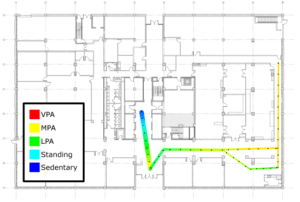The combination of big data from indoor positioning systems and accelerometry enables indoor physical activity mapping and allows extraction of interesting insights into the physical activity and movement of occupants in a building or facility.
Regular participation in physical activity at the workplace has beneficial effects on the well-being of employees1,2,3. For instance, fitness programs encouraged by employers have been shown to increase employee’s productivity, reduce direct costs associated with health care expenses and also reduce absenteeism,4. Similarly, including physical activity in heathcare settings promotes the recovery process of patients. Shorter recuperation times were observed among stroke-victims and older adults who consistently performed physical exercises in hospital and at home 5,6. Given the importance of regular physical activity, it is beneficial to investigate the associations between the level of physical activity and pattern of physical activity at various locations in an environment.

Figure 1. Coverage of a facility by Bluetooth gateways

Figure 2. Heatmap reconstruction based on people in a given area per hour (P/h)
By combining activity sensors that monitor the level of physical activity and strategically placed Bluetooth gateways for indoor tracking of these sensors (Figure 1), several key characteristics of human activity in an environment such as an office space, factory plant or hospital can be analysed.
Physical activity mapping not only allows for the generation of heatmaps that display the presence and crowding in an area at any given point or period in time (Figure 2), but also identify physical activity levels in these areas (Figure 3). Therefore it is possible to distinguish between areas that are frequently visited and areas where people are highly active.
With precise indoor tracking, it is easy to reconstruct single or multiple user scenarios to get an insight into popular routes in a building or production line. In combination with the data recorded from accelerometers, the level and duration of activity along single or multiple routes can be determined. Another huge advantage of this system is its immediate access to real-time information, which provides reliable and precise analyses of the current situation in a building or facility.
There are many versatile applications and solutions with indoor physical activity mapping. Some examples include:
- Characterizing physical activity behavior in a workplace
- Investigating the efficacy of health promotion interventions in an environment
- Patient activity and location monitoring in the healthcare sector
- Facility and infrastructure planning

Figure 3. Reconstruction of route taken by a single person and activity along the way expressed in 5 levels: VPA – vigorous physical activity, MPA – moderate physical activity, LPA – low physical activity.
Get in touch with us to explore possibilities of the system and the various powerful analyses to suit user specifications.
References
- Pronk NP, Kottke TE. Physical activity promotion as a strategic corporate priority to improve worker health and business performance. Preventive medicine. 2009 Oct 31;49(4):316-21.
- Batt ME. Physical activity interventions in the workplace: the rationale and future direction for workplace wellness. British journal of sports medicine. 2009 Jan 1;43(1):47-8.
- Buckley JP, Hedge A, Yates T, Copeland RJ, Loosemore M, Hamer M, Bradley G, Dunstan DW. The sedentary office: a growing case for change towards better health and productivity. Expert statement commissioned by Public Health England and the Active Working Community Interest Company. Br J Sports Med. 2015 Jun 17:bjsports-2015.
- Ammendolia C, Côté P, Cancelliere C, et al. Healthy and productive workers: using intervention mapping to design a workplace health promotion and wellness program to improve presenteeism. BMC Public Health. 2016;16:1190.
- Mattlage AE, Redlin SA, Rippee MG, et al. Use of Accelerometers to Examine Sedentary Time on an Acute Stroke Unit. Journal of neurologic physical therapy. 2015 39.
- Shadmi E & Zisberg A. In-hospital mobility and length of stay. Archives of internal medicine, 2011, 171.14: 1298-1299.
